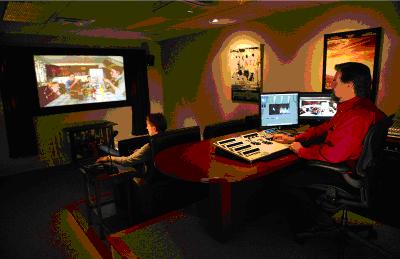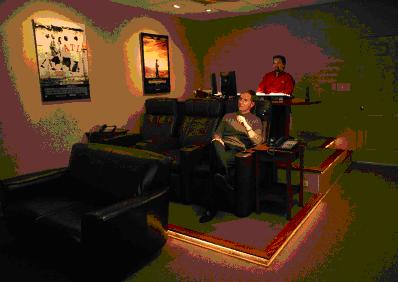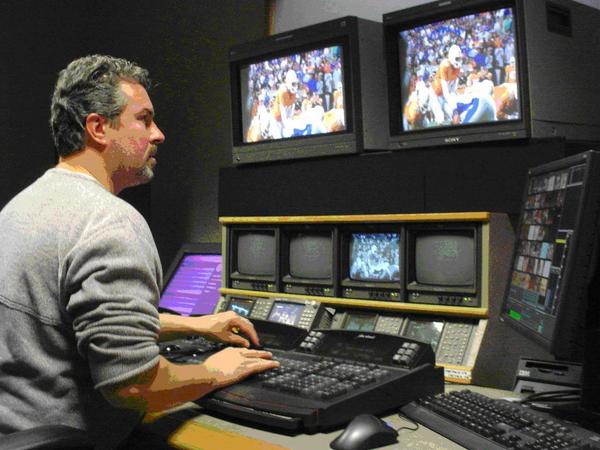Hollywood In The South
Breaking News
PRODUCTION HOTLINE
Festivals
Contests
Casting Calls
Crew Calls
Announcements
Industry Events
To submit press room text, including production hotline content, please click here. To submit press room images and text, e-mail us at production@filmmakersouth.com.
HOLLYWOOD IN THE SOUTH
Digital Intermediate Suite Premieres at Cinefilm
Atlanta, GA. – January of 2007 marked a new addition to the services of Atlanta-based Cinefilm with the launch of their new Digital Intermediate Suite. The suite is a complement to the two existing film transfer suites that feature a Spirit 2K and Quadra with DaVinci color correction. “Our DI suite will allow us to provide features clients full support from dailies to final color correction for a film out” notes General Manager Jim Ogburn. “The marketplace is moving toward DI finish instead of the traditional AB roll film finish and we wanted to be the pioneer for that in the Atlanta and Southeast market.”
Cinefilm will be the first company in Atlanta to provide color correction in a theater setting with 4:4:4 digital projection on a screen. “Many companies are performing color correction using standard HD monitors,” explains Ron Anderson, Senior Colorist for Cinefilm, “but the look of light reflected from a movie screen is different than RGB additive color from HD monitors. Projection viewing is the standard in Los Angeles and we wanted to give our clients that same quality.”

Cinefilm Account Manager Joe Huggins helped research and design the new suite as an answer to client demands. “We do the lab work and dailies for Hollywood features like “We Are Marshall,” Huggins proudly notes, “but our lower budget indie clients needed a cost effective process for DI. We are technically an HD-DI at 1920x1080, but that roughly 80 lines less resolution than a 2K scan is negligible, and having scans made would cost a client $26,000 before he even began to color correct. We can provide the final transfer and correction for slightly more than that price at virtually identical quality.”
What makes the a workflow at Cinefilm unique among HD-DI processes, is the media stays 10bit -uncompressed digital all the way to a film out. Even HDCam SR 444 has 2.7:1 compression on tape, the film transfers to drive will never see tape compression anywhere in the process. “What we have to offer is something most post houses do not,” boasts Huggins, “we do not have editors that will be trying their hand at color correction, we have full-time colorists. With projection grading in 4:4:4 HD with true color specialist, there’s no compromise on your image.”
Cinefilm will also provide sample tests of select scenes to 35mm film out and project those in the film screening room adjacent to the DI suite. That way, the client is assured that the look on the digital projection matches the color and density of the prints. Having a lab in the same facility is an added bonus.

CINEFILM ON THE PERFORMING THE LAB WORK FOR WARNER BROTHERS’
WE ARE MARSHALL

Feature Production in Georgia has increased in the last year hosting two Warner Brothers films, the most recent being We Are Marshall. Cinefilm was the first draft pick as the lab for this football story starring Matthew McConaughey. The three month production started in West Virginia then finished the majority of location work in the Atlanta area where Cinefilm handled all the processing and HD dailies work.
Marshall is the emotional story of the Marshall University Football team that perished in a plane crash when returning from a football game in 1970. The team's new coach (McConaughey) and his surviving players try to keep the football program alive. Director McG teamed with DP Shane Hurlbut on this heart-warming story of a town that moves from tragedy to triumph. Along with McConaughey, Oscar-nominated actor David Strathairn, and Matthew Fox have lead roles.
“We were excited to have another WB feature in Atlanta,” notes Joe Huggins, Cinefilm Account Manager, “having had an excellent experience with The ATL a few months earlier. Being called again is always a nod of endorsement.” In both films, the post was also handled on location using Avid systems tied together with the Unity central storage and getting the dailies right and fast was the challenge in both cases.
Most features shoot between 200-300,000 feet of 35mm, and The ATL topped about 400,000 feet. But the multiple camera work in the football stadium and crowd scenes of Marshall took the total to over 900,000 feet! “This was my first experience with Cinefilm,” comments DP Hurlbut, “and I have to say I was impressed. With a shoot our size, I wasn’t sure how well a small lab, when compared to some in LA, would perform, but they were great.” Making sure the DP is happy each day is not an easy task, but colorist John Petersen was up to it.
“I met with Shane early on to set up the look in our Spirit suite,” explains Petersen. “He had samples from books of old Kodachrome prints that he wanted to match. The way it handled blacks and green grass and bright primary colors took some time to match, and to be sure he was satisfied, but after that, we ‘rocked’.”
The 35mm film was transferred to HDCam for viewing dailies on the set and DBeta for the editors to cut each day. The studios then often use the HD tapes to conform for promos and trailers while the film is in final post. With some days shooting 40,000’ feet of film, that was a lot of transfer work and material to edit. Pricilla Ned-Friendly was the editor on location from the west coast, and Atlanta’s own Joe Binford, who also worked on The ATL was Assistant Editor responsible for syncing and prepping the tapes each day and helped develop the workflow from the lab to edit.
Cinefilm is beginning it’s 30th year in serving features, commercial, and industrial producers throughout the South and across the country. “We’ve added an office now in Baton Rouge to service the growing film industry in Louisiana due to their tax incentive programs, and have one planned for South Carolina,” adds Huggins with a smile, “my motto is like that of Vegas – ‘What’s shot in the South, Stays in the South- at least for processing and dailies.”
Cinefilm is also about to announce their new tape-less all digital suite for Digital Intermediates and film outs. It looks like they are poised to keep even more film work in the South.
THE MAYFLOWER: HISTORY AS DRAMA
Many of us remember the Pilgrims from grade school plays or as a boring chapter that was required in high school. But far from that, it is an incredible human drama brought to the screen in an epic three hour special by The History Channel. Desperate Crossing: The Untold Story of the Mayflower, produced by Lone Wolf Documentary Group of Portland, Maine, premieres this November as one of the network’s marquee programming events. Styled in the look and feel of a feature film, it almost seems inappropriate to describe the program as a ‘docu-drama.’ Helping to create that cinematic look was the task of Cinefilm in Atlanta where the final color correction was performed.
The production went to great lengths to capture the drama of this small band of religious rebels and their epic journey from England to Holland and across the Atlantic to the New World. Shooting took place on location in Massachusetts at Plimoth Plantation and in Maryland and Virginia, as well as in Europe. The cast features Royal Shakespeare Company actors as well as members of the Wampanoag Indian tribe. With a special of this scale and complexity it is easy for costs to sky-rocket.
“In an effort to keep costs down, we made the decision early on to shoot in HD rather than film,” explains Writer-Producer-Director Lisa Wolfinger as she oversees the color correction in the main suite at Cinefilm. “We shot with the new Sony HDV camera and lighted as if it were film with a dark, cinematic look. Some of the scenes in the hull of the Mayflower II (a full replica of the original) were lit only with lantern light to give it an authentic feel. We wanted to be sure viewers ‘felt’ the claustrophobia the original colonists would have felt in the bowels of the ship at sea. But shooting in such low light can be tricky, it can get very muddy fast. We took a big risk counting on color correcting to get the final look we wanted.
Colorist Ron Anderson was able to bring out the detail in the blacks (which you get with film) and give it a very cinematic look, the HDV material looks remarkable.”
Special adapters were used with the Sony HDV camera to allow the standard zoom lense to accommodate 35mm primes. “That allowed us to create a shallower depth of field which is often critical to a cinematic look,” notes Tony Bacon, First AD and Co-Editor. “We then converted the 1080i HDV mpeg stream to HD-SDI with a Mirada converter, and digitized the show into the Avid Adrenaline. Third party film motion and grain effects were added, before the final color correction at Cinefilm. It’s a very post intensive path, but I think people will be stunned to see how good HDV can look."
It seems a bit unusual for a Maine production company not to be finishing in Boston or New York, but not so with Lone Wolf. “We discovered Ron (Senior Colorist Ron Anderson) several years ago when working with an Atlanta DP on our Deep Sea Detectives series,” said Wolfinger with a smile, “and whether we shoot on film or tape, we wouldn’t finish a special now without him. The HDV material looked good to begin with, but Ron really pushed the look to a whole new level. It was as though he lifted a ‘haze’ off the HD video to make it look like 35mm film. You just can’t get the same color results from non-linear editors.” “Lone Wolf’s projects are always exciting to be a part of,” replies Anderson, “not only for the technical challenges, but the scope and quality of the content. The control you have with the daVinci 2K using the Colorist Toolbox is especially important when working from an edited tape master to create a film look.”
Though much of the Pilgrims’ look is ‘dark’ – from the clothing, to the ships hull, to the cold winter scenes – there are dramatic and visual contrasts with the vivid colors of the scenes in Elizabethan England and Holland during that period. When watching the special, you forget it’s a documentary as you get absorbed into the drama. Sure, there are noted academics and historians adding commentary, but they feel more like the ‘Witnesses’ intercut in Warren Beaty’s feature “Reds”. In more ways than one, the producers have cast the Mayflower and our nations founding in a whole new dramatic light.
It’s our history interpreted as drama…or more appropriately, the drama of our history. The interior hull of the Mayflower II along with the dark clothing of the Pilgrims illustrates the challenge of holding detail in the blacks in the HD color correction of this dramatic special for the History Channel.
The producers went to great lengths to authentically recreate the Pilgrim’s meetings with the Wampanoag native people. Being sure the subtle colors and moods of these scenes were maintained was a challenge for Cinefilm colorist, Ron Anderson, correcting tape-to-tape in the DVCPro HD format.
The drama of the Mayflower crossing was not all dark moods as evidenced by this scene in the courts of England. Writer-Director Lisa Wolfinger, right, sets up a shot with actors from the Royal Shakespeare Company.